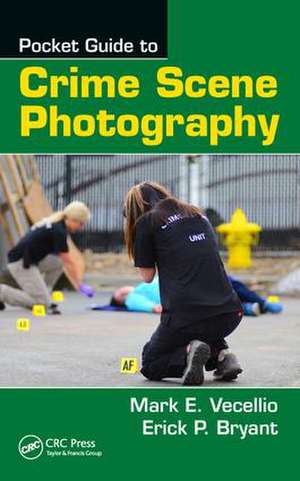Pocket Guide to Crime Scene Photography
Autor Mark E. Vecellio, Erick P. Bryanten Limba Engleză Hardback – 14 iul 2017
| Toate formatele și edițiile | Preț | Express |
|---|---|---|
| Paperback (1) | 213.79 lei 6-8 săpt. | |
| Taylor & Francis – 31 mar 2021 | 213.79 lei 6-8 săpt. | |
| Hardback (1) | 651.21 lei 6-8 săpt. | |
| Taylor & Francis – 14 iul 2017 | 651.21 lei 6-8 săpt. |
Preț: 651.21 lei
Preț vechi: 875.72 lei
-26% Nou
Puncte Express: 977
Preț estimativ în valută:
124.61€ • 130.45$ • 103.11£
124.61€ • 130.45$ • 103.11£
Carte tipărită la comandă
Livrare economică 05-19 aprilie
Preluare comenzi: 021 569.72.76
Specificații
ISBN-13: 9781498768238
ISBN-10: 1498768237
Pagini: 204
Ilustrații: 134 Halftones, color; 134 Illustrations, color
Dimensiuni: 138 x 216 x 17 mm
Greutate: 0.36 kg
Ediția:1
Editura: Taylor & Francis
Colecția CRC Press
Locul publicării:Oxford, United Kingdom
ISBN-10: 1498768237
Pagini: 204
Ilustrații: 134 Halftones, color; 134 Illustrations, color
Dimensiuni: 138 x 216 x 17 mm
Greutate: 0.36 kg
Ediția:1
Editura: Taylor & Francis
Colecția CRC Press
Locul publicării:Oxford, United Kingdom
Public țintă
Academic, Professional, and Professional Practice & DevelopmentCuprins
Preface
Chapter 1: Providing Context
Chapter 2: Equipment and Accessories
Chapter 3: Camera Terms and Photography Principles Made Easy
Chapter 4: Crime Scene Photography: An Overview and Checklist
Chapter 5: Overall Photographs
Chapter 6: Mid-range Photographs
Chapter 7: Close-up Photographs
Chapter 8: Photographing Footwear/Tire Tracks and Impressions
Chapter 9: Photographing Latent Fingerprints
Chapter 10: Night Photography, Painting with Light, Long Shutter Duration Photography
Chapter 11: Alternate Light Source Photography
Chapter 12: Photographing Vehicles
Chapter 13: Injury/Deceased Remains Photography
Chapter 1: Providing Context
Chapter 2: Equipment and Accessories
Chapter 3: Camera Terms and Photography Principles Made Easy
Chapter 4: Crime Scene Photography: An Overview and Checklist
Chapter 5: Overall Photographs
Chapter 6: Mid-range Photographs
Chapter 7: Close-up Photographs
Chapter 8: Photographing Footwear/Tire Tracks and Impressions
Chapter 9: Photographing Latent Fingerprints
Chapter 10: Night Photography, Painting with Light, Long Shutter Duration Photography
Chapter 11: Alternate Light Source Photography
Chapter 12: Photographing Vehicles
Chapter 13: Injury/Deceased Remains Photography
Notă biografică
Mark E. Vecellio is currently an instructor at Fayetteville Technical Community College, in North Carolina. He previously served in the U.S. Army Criminal Investigations Command from 1995 to 2011. He is a current member of numerous forensic science organizations and has led investigative task forces in robbery, rape, and arson crimes.
Erick P. Bryant currently serves as Crime Scene Analyst with the Colorado Bureau of Investigation and previously served with the U.S. Army Criminal Investigation Command (CID) where he retired as the Chief, Policy Branch at the U.S. Army CID Headquarters in Quantico, VA. He has expertise in crime scene investigation, analysis and reconstruction, forensic photography, bloodstain pattern analysis, and criminal, sexual assault, and death investigation, among others areas. He currently holds membership in the American Academy of Forensic Science (AAFS) and the International Association for Identification (IAI).
Erick P. Bryant currently serves as Crime Scene Analyst with the Colorado Bureau of Investigation and previously served with the U.S. Army Criminal Investigation Command (CID) where he retired as the Chief, Policy Branch at the U.S. Army CID Headquarters in Quantico, VA. He has expertise in crime scene investigation, analysis and reconstruction, forensic photography, bloodstain pattern analysis, and criminal, sexual assault, and death investigation, among others areas. He currently holds membership in the American Academy of Forensic Science (AAFS) and the International Association for Identification (IAI).
Descriere
This pocket guide is an essential field guide to crime scene photography. The authors have used limited technical terms and jargon to distill concepts down to understandable, step-by-step methodologies. The book highlights best practices that apply to most any crime scene but specialized instructions—pertaining to unique evidence and crime scenes that present challenging conditions—are also provided. The book introduces concise, comprehensive checklists for photographing such evidence as tire tracks, dust impressions, fingerprints, luminescence from trace blood search reagents, and more.
